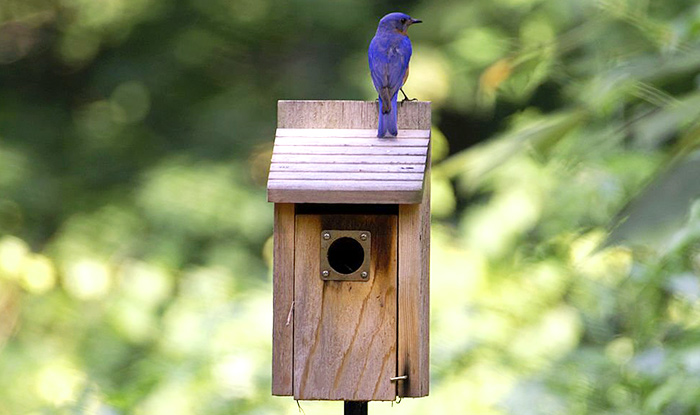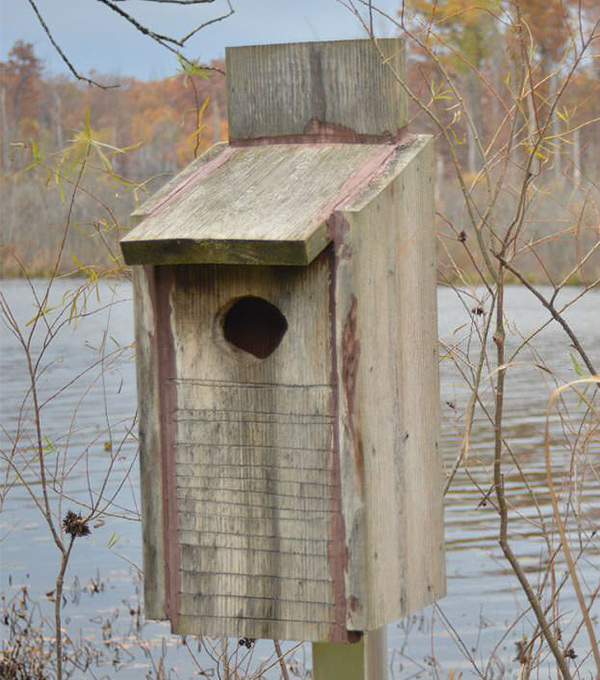Bluebirds are among the most cherished backyard visitors for avid and casual birdwatchers. Known for their vibrant coloration and melodious songs, bluebirds are the type of backyard visitor that you would not mind staying in your yard forever.
If you do want these birds to make a permanent home out of your yard, you should place a birdhouse for them. In this article, you will learn where to place a bluebird house so that it could attract and comfortably accommodate the birds.
If you understand what bluebirds need and want, you can increase the chances that a family of them will use your birdhouse as their new home.
Contents
Choosing the Best Location for Bluebird House
How do you figure out the best location for a bluebird house? To entice bluebirds to actually use the birdhouse that you put out, make sure that you put it in a spot that meets the following requirements:
Open space with moderate amounts of vegetation
Bluebirds tend to thrive in habitats that contain a balance of open space with a moderate number of trees and bushes. When searching for the ideal location, look for a place that will provide the bluebirds with a clear view of their surroundings.
This is what these bird species prefer as this allows them to spot potential predators easily. Do not place the bluebird house in a densely wooded area or any spot that has tall and thick shrubbery as this can affect the visibility of the bluebirds.
Far enough from human activity
Although bluebirds can somewhat easily adapt to living in an area with humans nearby, they are still quite easily startled. You will need to place the bluebird house in a location that is far enough away from high-traffic areas and loud noises.
Ideally, the best place to hang a bluebird house is at least 50 feet away from human activity, which includes your house.
Avoidance of predatory threats
Bluebirds will not nest in a place where there is a high potential for predators to reach them. You should be strategic when coming up with the placement of the birdhouse. For instance, mount the birdhouse on a smooth metal pole, or install baffles near the top to keep climbing animals from reaching the nest.
Also, keep the birdhouse at least 5 feet off the ground. This is so you can discourage predators and still provide easy access for the birds.
Proper sun exposure
Bluebirds prefer to build their nests in a place that receives enough sunlight. However, this does not mean the birdhouse should not get any shade at all. To make the nest more attractive, make sure that the birdhouse receives enough morning sun, and minimal to no afternoon sun.
Observe the location for about a day to make sure that it is almost perfect. Also, do not position the birdhouse facing north. These tend to make the birdhouse a bit too cold and less desirable to bluebirds.
Far away from other bluebird houses
Bluebirds are highly territorial and they would rather nest somewhere far from other bluebirds. If you will be placing multiple bluebird houses, make sure that they are at least 100 yards away from each other to minimize competition and avoid territorial disputes between the birds.
By providing enough distance between the birdhouses, you will be increasing the chances of successful nesting of the bluebirds while reducing the amount of stress the birds’ experience. This will also increase the chances of the birds multiplying.
Nearby water source
Bluebirds, just like other small nesting birds, would rather nest in an area where they have easy access to a source of clean water. A few examples would be a birdbath, pond, or small stream. They need this so they have water to drink and clean themselves.
They will choose a nesting place that is near a water source so they do not need to fly too far. This is especially important during the nesting season when the parents cannot wander too far from the nest.
Consideration of environmental factors
You also have to consider the environmental conditions in your area when you are deciding on a location for your bluebird house. Consider the prevailing winds, exposure to inclement weather, and the local climate when you are choosing a location.
Ensure that you will be placing the birdhouse where it can get proper shelter against storms and heavy rains. Avoid areas that get a bit too much wind as it will only distress the birds and make them not want to nest there.
You should also avoid the edges of the tree canopies as it would cause rainwater to pour into the birdhouse and may cause mold to grow.
Ease of access for regular monitoring and maintenance
Another consideration when choosing a location for your bluebird house is whether or not you can access it easily whenever you need to do repairs and maintenance later. If possible, put the birdhouse where you can always see it, so you will know immediately if it needs repairs.
Speaking of maintenance, you should put out the nest box at least once a year during the late winter, or early spring if the birds have not come back yet. You should do this to prepare the birdhouse for the next family of birds to roost.
Conclusion
Although there are quite a lot of things that you need to consider when choosing where to place a bluebird house, trust me, it will be worth your while. If you choose the location carefully, it will almost guarantee that bluebirds will be building their nests in your birdhouses.
Having a family of bluebirds in your yard will not just provide you with endless entertainment. You will also be helping them by providing them with a suitable birdhouse.







